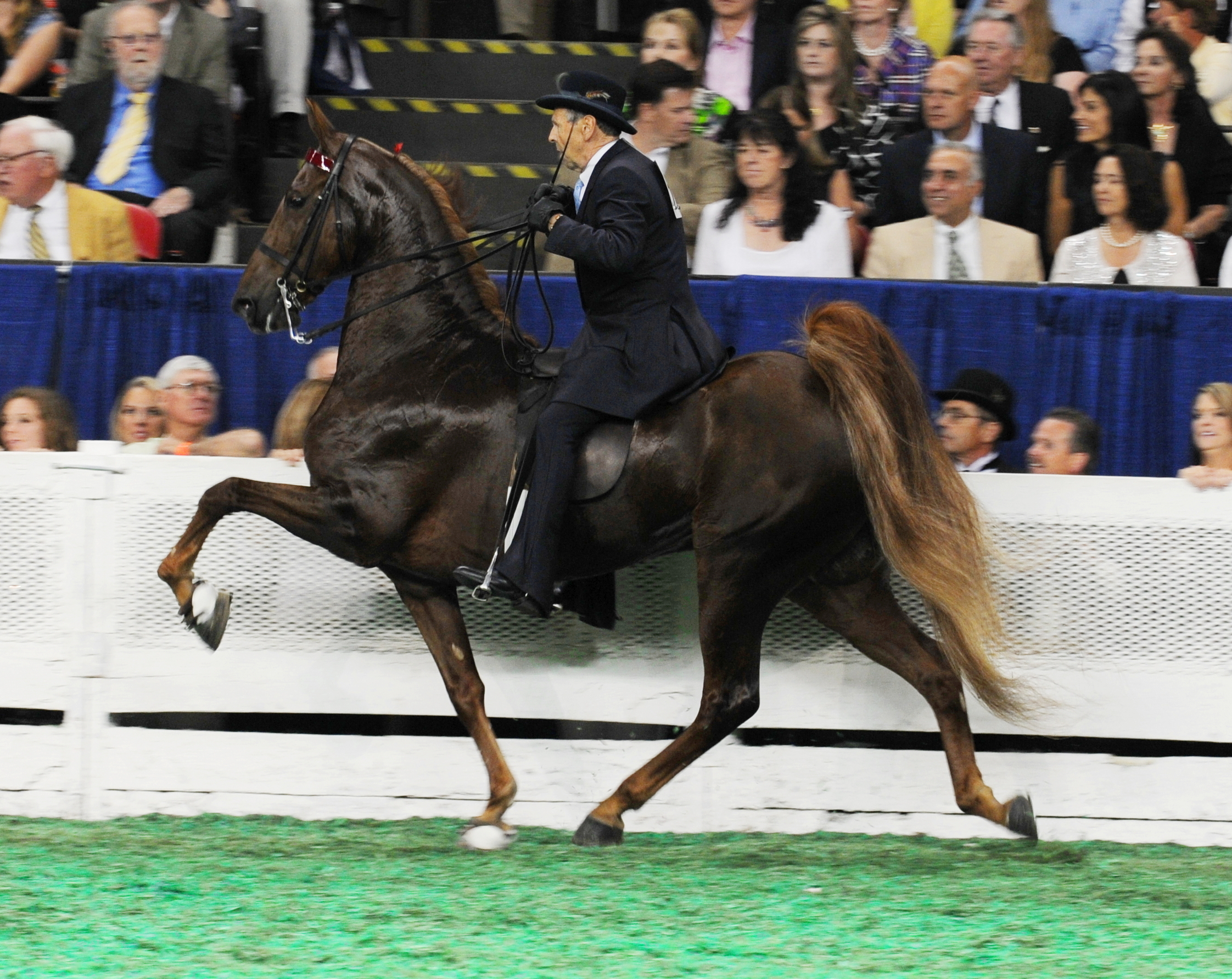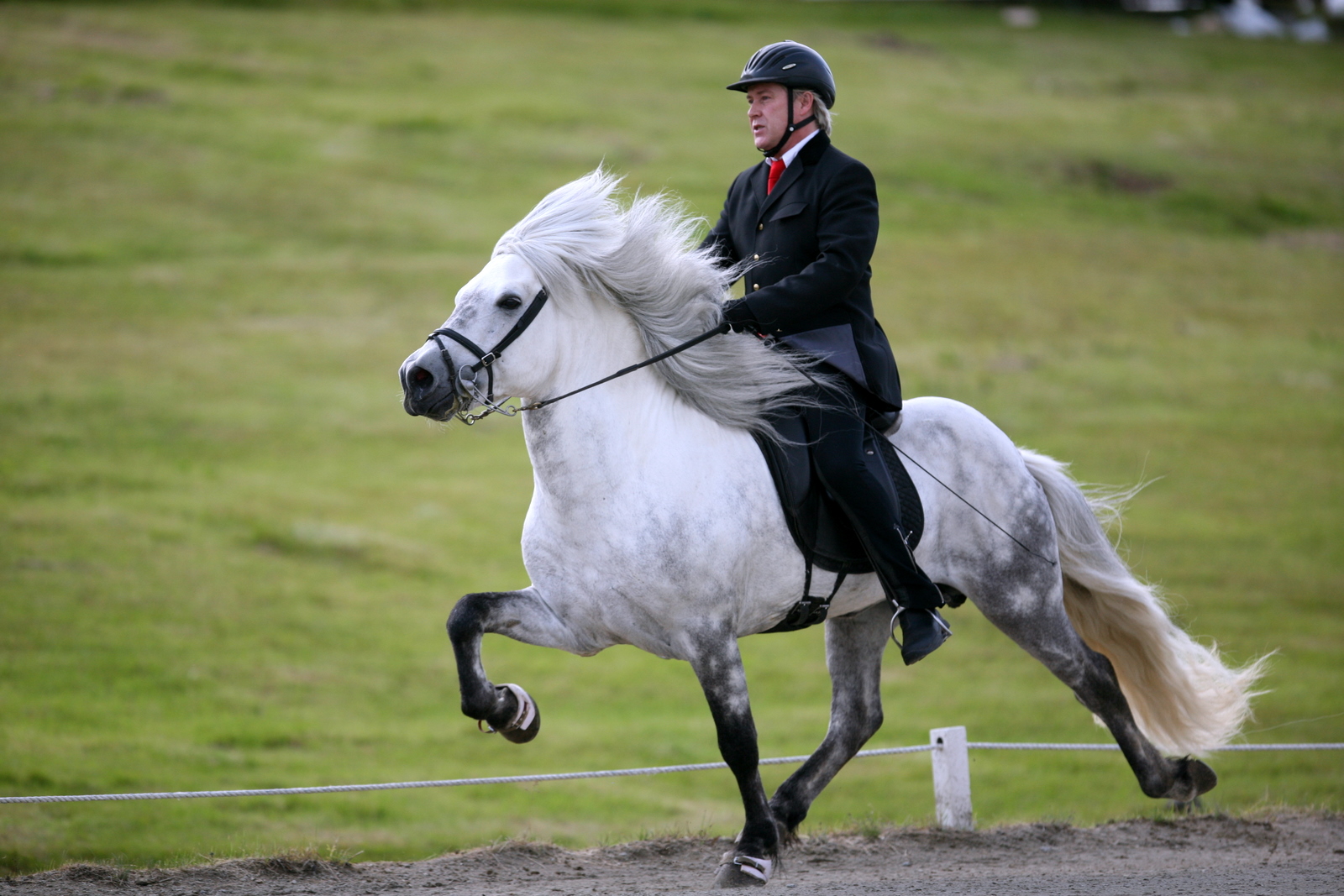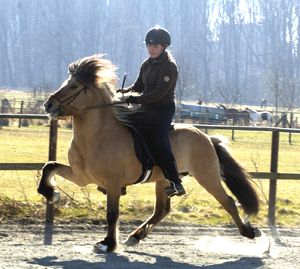|
My-My (horse)
My-My (1957–1968) was an American Saddlebred mare. She was one of only two horses ever to win six Five-Gaited World's Grand Championships in the World's Championship Horse Show. Life My-My was foaled in 1957. Her dam, Daneshall's Easter Parade, was the only horse to ever beat Wing Commander, the only other six-time World Grand Champion. Her sire was Beau Fortune. My-My died October 1 1968, of liver failure. She was eleven years old. Career My-My was trained by Frank Bradshaw, and won a total of six five-gaited World Grand Championships at the World's Championship Horse Show, from 1963 to 1968. When she won her first World title in 1963, she was owned by Daneshall Stables, but she was sold to Jolie Richardson of Atlanta, Georgia before the second title. My-My was a five-gaited horse, meaning she performed the walk, trot, canter, slow gait and rack. Jolie Richardson was in the hospital with cancer Cancer is a group of diseases involving abnormal cell growth with the po ... [...More Info...] [...Related Items...] OR: [Wikipedia] [Google] [Baidu] |
American Saddlebred
The American Saddlebred is a horse breed from the United States. This breed is referred to as the "Horse America Made". Descended from riding-type horses bred at the time of the American Revolution, the American Saddlebred includes the Narragansett Pacer, Canadian Pacer, Morgan and Thoroughbred among its ancestors. Developed into its modern type in Kentucky, it was once known as the "Kentucky Saddler", and used extensively as an officer's mount in the American Civil War. In 1891, a breed registry was formed in the United States. Throughout the 20th century, the breed's popularity continued to grow in the United States, and exports began to South Africa and Great Britain. Since the formation of the US registry, almost 250,000 American Saddlebreds have been registered, and can now be found around the world, with separate breed registries established in Great Britain, Australia, continental Europe, and southern Africa. Averaging in height, Saddlebreds are known for their sen ... [...More Info...] [...Related Items...] OR: [Wikipedia] [Google] [Baidu] |
Five-gaited
Five-gaited horses are notable for their ability to perform five distinct horse gaits instead of simply the three gaits, walk, trot and canter or gallop common to most horses. Individual animals with this ability are often seen in the American Saddlebred horse breed, though the Icelandic horse also has five-gaited individuals, though with a different set of gaits than the Saddlebred. The ability to perform an ambling gait or to pace appears to be due to a specific genetic mutation. Some horses are able to both trot and perform an ambling gait, but many can only do one or the other, thus five-gaited ability is not particularly common in the horse world. In the American Saddlebred and related breeds, the five gaits performed are the walk, trot, canter, and two ambling gaits: the rack, a fast, lateral, four-beat gait that is synchronous— "each foot meets the ground at equal, separate intervals"; and a "slow gait", a slower, smooth collected four-beat gait that is asynchronous � ... [...More Info...] [...Related Items...] OR: [Wikipedia] [Google] [Baidu] |
Five-Gaited
Five-gaited horses are notable for their ability to perform five distinct horse gaits instead of simply the three gaits, walk, trot and canter or gallop common to most horses. Individual animals with this ability are often seen in the American Saddlebred horse breed, though the Icelandic horse also has five-gaited individuals, though with a different set of gaits than the Saddlebred. The ability to perform an ambling gait or to pace appears to be due to a specific genetic mutation. Some horses are able to both trot and perform an ambling gait, but many can only do one or the other, thus five-gaited ability is not particularly common in the horse world. In the American Saddlebred and related breeds, the five gaits performed are the walk, trot, canter, and two ambling gaits: the rack, a fast, lateral, four-beat gait that is synchronous— "each foot meets the ground at equal, separate intervals"; and a "slow gait", a slower, smooth collected four-beat gait that is asynchronous � ... [...More Info...] [...Related Items...] OR: [Wikipedia] [Google] [Baidu] |
World's Championship Horse Show
The World's Championship Horse Show, held at the Kentucky Exposition Center, Kentucky State Fairgrounds in Louisville, Kentucky, in Freedom Hall, is a large horse show that includes the American Saddlebred, Hackney pony, Dutch Harness Horse, and Standardbred breeds. It is usually held annually in late August, coinciding with the dates of the Kentucky State Fair and in the middle of the show season for the three breeds. Any horse or rider who wins there earns the title of World's Champion (abbreviation: WC), and a second-place finish is identified with a Reserve World's Championship (abbreviation: RWC) title. In addition to the WC and RWC titles, a horse can also earn the World's Grand Championship (WGC) or World's Championship of Champions (WCC) title. The winner of a championship class which requires a qualifier is given one of these titles. Competition American Saddlebred horses, Hackney ponies and horses, and Standardbred horses compete in the World's Championship. In each di ... [...More Info...] [...Related Items...] OR: [Wikipedia] [Google] [Baidu] |
Foal
A foal is an equine up to one year old; this term is used mainly for horses, but can be used for donkeys. More specific terms are colt for a male foal and filly for a female foal, and are used until the horse is three or four. When the foal is nursing from its dam (mother), it may also be called a "suckling". After it has been weaned from its dam, it may be called a "weanling". When a mare is pregnant, she is said to be "in foal". When the mare gives birth, she is "foaling", and the impending birth is usually stated as "to foal". A newborn horse is "foaled". After a horse is one year old, it is no longer a foal, and is a "yearling". There are no special age-related terms for young horses older than yearlings. When young horses reach breeding maturity, the terms change: a filly over three (four in horse racing) is called a mare, and a colt over three is called a stallion. A castrated male horse is called a gelding regardless of age; however, colloquially, the term "gelding col ... [...More Info...] [...Related Items...] OR: [Wikipedia] [Google] [Baidu] |
Wing Commander (horse)
Wing Commander (1943–1969) was an American Saddlebred show horse out of the mare Flirtation Walk and by the stallion Anacacho Shamrock. Wing Commander was a chestnut with four white socks and a thin white stripe that ran from his forehead all the way to his upper lip. He was trained to be a five-gaited horse, meaning he performed the walk, trot, canter, slow gait and rack. Through both sides of his pedigree, Wing Commander traced back to the highly influential Saddlebred stallions Rex McDonald and Bourbon King, who were themselves successful show horses. In 1948, the stallion won his first Five-Gaited World Grand Championship, a title he kept for a total of six years. In total he won 6 Five-Gaited World Grand Championships, and was the first of only two horses to accomplish this. In 1950 ''Life'' magazine featured Wing Commander as an example of a fine athlete and an American Idol. He was owned by Dodge Stables, and trained and ridden by Earl Teater. Wing Commander stood at s ... [...More Info...] [...Related Items...] OR: [Wikipedia] [Google] [Baidu] |
Atlanta, Georgia
Atlanta ( ) is the capital and most populous city of the U.S. state of Georgia. It is the seat of Fulton County, the most populous county in Georgia, but its territory falls in both Fulton and DeKalb counties. With a population of 498,715 living within the city limits, it is the eighth most populous city in the Southeast and 38th most populous city in the United States according to the 2020 U.S. census. It is the core of the much larger Atlanta metropolitan area, which is home to more than 6.1 million people, making it the eighth-largest metropolitan area in the United States. Situated among the foothills of the Appalachian Mountains at an elevation of just over above sea level, it features unique topography that includes rolling hills, lush greenery, and the most dense urban tree coverage of any major city in the United States. Atlanta was originally founded as the terminus of a major state-sponsored railroad, but it soon became the convergence point among several rai ... [...More Info...] [...Related Items...] OR: [Wikipedia] [Google] [Baidu] |
Trot
The trot is a ten-beat diagonal horse gait where the diagonal pairs of legs move forward at the same time with a moment of suspension between each beat. It has a wide variation in possible speeds, but averages about . A very slow trot is sometimes referred to as a jog. An extremely fast trot has no special name, but in harness racing, the trot of a Standardbred is faster than the gallop of the average non- racehorse, and has been clocked at over . On June 29, 2014, at Pocono Downs in Pennsylvania the Swedish standardbred Sebastian K trotted a mile in 1 minute, 49 seconds (quarters were passed at 26:2, 55:3 and 1,21:4). This is equivalent to a 1000-pace in 1.07,7 or 53.14 kilometers per hour or 33 miles per hour. From the standpoint of the balance of the horse, the trot is a very stable gait and does not require the horse to make major balancing motions with its head and neck.Harris, Susan E. ''Horse Gaits, Balance and Movement'' New York: Howell Book House 1993 pp. 35–37 D ... [...More Info...] [...Related Items...] OR: [Wikipedia] [Google] [Baidu] |
Canter
The canter and gallop are variations on the fastest gait that can be performed by a horse or other equine. The canter is a controlled three-beat gait, while the gallop is a faster, four-beat variation of the same gait. It is a natural gait possessed by all horses, faster than most horses' trot, or ambling gaits. The gallop is the fastest gait of the horse, averaging about . The speed of the canter varies between depending on the length of the horse's stride. A variation of the canter, seen in western riding, is called a lope, and is generally quite slow, no more than . Etymology Since the earliest dictionaries there has been a commonly agreed suggestion that the origin of the word "canter" comes from the English city of Canterbury, a place of pilgrimage in the Middle Ages, as referred to in ''The Canterbury Tales'', where the comfortable speed for a pilgrim travelling some distance on horseback was above that of a trot but below that of a gallop. However a lack of compelli ... [...More Info...] [...Related Items...] OR: [Wikipedia] [Google] [Baidu] |
Ambling Gait
An ambling gait or amble is any of several four-beat intermediate horse gaits, all of which are faster than a walk but usually slower than a canter and always slower than a gallop. Horses that amble are sometimes referred to as "gaited", particularly in the United States. Ambling gaits are smoother for a rider than either the two-beat trot or pace and most can be sustained for relatively long periods, making them particularly desirable for trail riding and other tasks where a rider must spend long periods in the saddle. Historically, horses able to amble were highly desired for riding long distances on poor roads. Once roads improved and carriage travel became popular, their use declined in Europe but continued in popularity in the Americas, particularly in areas where plantation agriculture was practiced and the inspection of fields and crops necessitated long daily rides. The ability to perform an ambling gait is usually an inherited trait. In 2012, a DNA study found that ... [...More Info...] [...Related Items...] OR: [Wikipedia] [Google] [Baidu] |
Cancer
Cancer is a group of diseases involving abnormal cell growth with the potential to invade or spread to other parts of the body. These contrast with benign tumors, which do not spread. Possible signs and symptoms include a lump, abnormal bleeding, prolonged cough, unexplained weight loss, and a change in bowel movements. While these symptoms may indicate cancer, they can also have other causes. Over 100 types of cancers affect humans. Tobacco use is the cause of about 22% of cancer deaths. Another 10% are due to obesity, poor diet, lack of physical activity or excessive drinking of alcohol. Other factors include certain infections, exposure to ionizing radiation, and environmental pollutants. In the developing world, 15% of cancers are due to infections such as ''Helicobacter pylori'', hepatitis B, hepatitis C, human papillomavirus infection, Epstein–Barr virus and human immunodeficiency virus (HIV). These factors act, at least partly, by changing the genes of ... [...More Info...] [...Related Items...] OR: [Wikipedia] [Google] [Baidu] |





